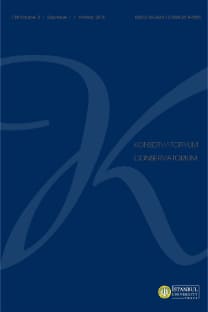Sonat Teorisi Yaklaşımıyla Bir Aşk Mektubunun Analizi: R. Schumann, Op.11/I
Robert Schumann’ın Op. 11, Birinci Piyano Sonatı’nın Birinci Bölüm’ü, birçok araştırmacı ve analist tarafından çeşitli yönleriyle değerlendirilmişse de eserin form yapısı hakkında, literatürde pek çok farklı görüş bulunmaktadır. Bu çalışmanın amacı, James Hepokoski ve Warren Darcy (2006) tarafından ortaya koyulmuş olan ve literatürde ‘Sonat Teorisi’ adıyla anılmakta olan form yaklaşımı üzerinden söz konusu eserin form yapısına dair yeni bir çözümleme önerisi sunmaktır. Bu çözümleme sırasında, eserin armonik ve tematik özellikleri de detaylıca ele alınmış, ayrıca eserin daha iyi anlaşılabilmesine olanak sağlamak amacıyla eserin yazılış amacı ve eserle ilgili tarihsel detaylar da göz önünde bulundurulmuştur. Zira Schumann, bu piyano sonatını takma bir isimle imzalayarak sevgilisi Clara Wieck’e ithaf etmiş ve eserin notasını doğrudan ona göndermiştir. Dolayısıyla Schumann’ın söz konusu piyano sonatını deyim yerindeyse bir aşk mektubu olarak değerlendirmek mümkündür. Gerçekleştirilen analizde, eserin bu özelliğinden kaynaklanan ve eserde metinlerarasılık yönünden bağlantılar kuran motifik ve tematik göndermeler de göz önünde bulundurulmuştur. Eser, ana çatısı itibariyle, minör moddaki sonatlarda sıkça karşılaşılan standart şablona uygun olarak kurgulanmışsa da formun iç yapısında, standartların dışında kalan ilgi çekici uygulamalar bulunmaktadır. Söz konusu uygulamalar, makalede detaylı olarak ele alınmıştır.
Anahtar Kelimeler:
Form Analizi, Sonat Teorisi, Robert Schumann
Analysis of a Love-Letter from the Perspective of Sonata Theory:R. Schumann, Op.11/I
The first movement of Robert Schumann’s Piano Sonata, Op. 11, has been evaluated in various aspects by many researchers and analysts. However, it seems that there are many different interpretations regarding its formal structure. The purpose of this study is to present a detailed formal analysis, based on the ‘Sonata Theory’ of James Hepokoski and William Darcy (2006). Besides the form analysis, the harmonic and thematic features of the movement were also discussed in detail. Furthermore, Schumann’s motivation for composing this sonata, and the historical context of the work are also taken into consideration. The composer dedicated this piano sonata to his future wife, Clara Wieck, and mailed it to her under a pseudonym. For this reason, it is possible to consider this Sonata as a ‘love-letter’. Therefore, the thematic and motivic intertextual references of the Sonata are also taken into consideration through the analysis. The findings of this study suggest that the movement in question was structured under the standard sonata framework typically seen in minor mode sonatas. However, closer scrutiny reveals that the Sonata contains some astonishing and delightful anomalies. In this paper, the radical aspects of the first movement of the Sonata are examined in detail.
Keywords:
Formal Analysis, Sonata Theory, Robert Schumann,
___
- Caplin, W. E. (1998). Classical form: A theory of formal functions for the instrumental music of Haydn, Mozart, and Beethoven. New York: Oxford University Press. google scholar
- Chernaik, J. (2011). Schumann’s Doppelgängers: Florestan and Eusebius revisited. The Musical Times, 152(1917), 45‒55. google scholar
- Daverio, J. (1997). Robert Schumann: Herald of a “new poetic age”. New York: Oxford University Press. google scholar
- Davis, A. C. (2007). Sonata fragments: Romantic narratives in Chopin, Schumann, and Brahms. Bloomington: In-diana University Press. google scholar
- Emberley, S. A. (2013). Robert Schumann’s Piano Sonata No. 1 in f-sharp minor, op. 11–Style and Structure. Dok-tora Tezi, James Madison University, Virginia. google scholar
- Fineartamerica (2018, Temmuz 20). Fandango by Robert Schumann. https://fineartamerica.com/featured/fandan-go-by-robert-schumann-robert-schumann.html google scholar
- Flynn, C. (1991). The Creative Art of Clara Schumann (1819‒1896). Yüksek Lisans Tezi, National University of Ireland, Maynooth. google scholar
- Gauldin, R. (2004). Harmonic Practice in Tonal Music. New York: W&W Norton & Company google scholar
- Harwood, G. W. (1980). Robert Schumann’s Sonata in F-Sharp Minor: A Study of Creative Process and Romantic Inspiration. Current Musicology, (29), 17‒30. google scholar
- Hepokoski, J. ve Darcy, W. (1997). The Medial Caesura and Its Role in the Eighteenth-Century Sonata Exposition. Music Theory Spectrum, 19(2), 115‒154 google scholar
- Hepokoski, J. ve Darcy, W. (2006). Elements of Sonata Theory: Norms, Types, and Deformations in the Late-Eigh-teenth-Century Sonata. New York: Oxford University Press. google scholar
- Jensen, E. F. (2012). The Master Musicians: Schumann. New York: Oxford University Press. google scholar
- Kim, K. (1980). A Critical Analysis of the First Movements of Schumann’s Piano Sonatas, Opus 11 and Opus 22 (Volume 1). The University of Oklahoma, Oklahoma. google scholar
- Lester, J. (1995). Robert Schumann and Sonata Forms. 19-th Century Music, 18(3), 189‒210. google scholar
- Litzmann, B. (2013). Clara Schumann: an Artist’s Life Based on Material Found in Diaries and Letter-Volume 1.Grace Eleanor Hadow (Çeviren). New York: Cambridge University Press. google scholar
- Parrott, I. (1952). A plea for Schumann’s Op. 11. Music&Letters, 33(1), 55‒58. google scholar
- Reich, N. B. (2001). Clara Schumann: The Artist and the Woman. New York: Cornell University Press. google scholar
- Richter, P. (2003). The Schumannian déjà vu: Special Strategies in Schumann’s Construction of Large-Scale Forms and Cycles. Studia Musicologica Academiae Scientiarum Hungaricae, 44(3/4), 305‒320. google scholar
- Rinaldi, R. (2003). European dance: Ireland, Poland, & Spain. New York: Chealse House Publishers. google scholar
- Rosen, C. (1988). Sonata Forms. New York: W. W. Norton & Company. Schumann, R. (1828). An Anna-II [Nota]. J. Brahms (Ed.), Robert Schumann’s Werke, Serie XIV: Supplement,s.34‒35. Breitkopf & Härtel (1893). google scholar
- Schumann, R. (1835). Grosse Sonata für das Pianoforte, Op. 11 [Nota]. C. Schumann (Ed.), Robert Schumann’s Werke, Serie VII: Für Pianoforte zu zwei Händen, s.52‒63. Breitkopf & Härtel (1887). google scholar
- Sears, D., Caplin, W., ve McAdams, S. (2014). Perceiving the Classical Cadence. Music Perception, 31/5, 397‒417 google scholar
- ISSN: 2146-264X
- Yayın Aralığı: Yılda 2 Sayı
- Başlangıç: 2011
- Yayıncı: İstanbul Üniversitesi Devlet Konservatuvarı
Sayıdaki Diğer Makaleler
Sonat Teorisi Yaklaşımıyla Bir Aşk Mektubunun Analizi: R. Schumann, Op.11/I
Makrokosmos I: George Crumb’in Eserinde Gelişmiş Piyano Teknikleri
Müziğin Ruhani Niteliklerine Yönelik Üç Bakış Açısı
Sonat Teorisi Üzerinden Bir Aşk Mektubunun Analizi: R. Schumann, Piyano Sonatı, No. 1, Op. 11/I
D. Shostakovich Viyola Sonati Op.147 Üzerine Teknik Açidan Bir İnceleme
